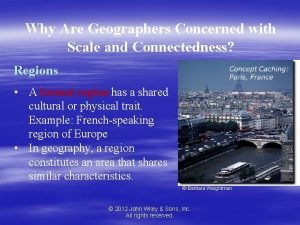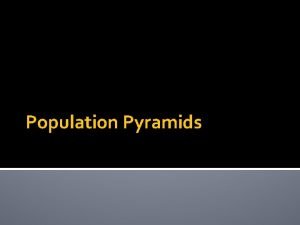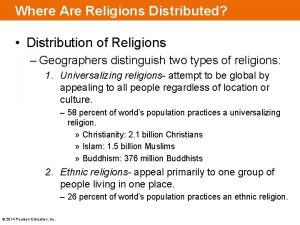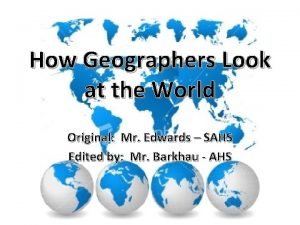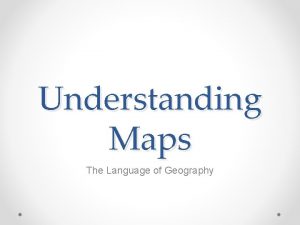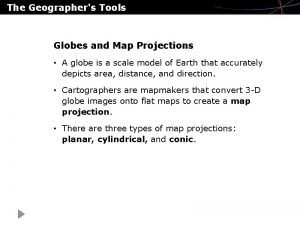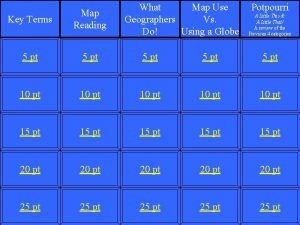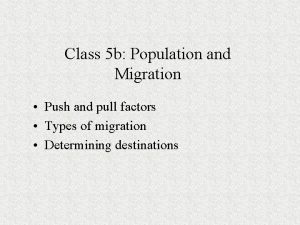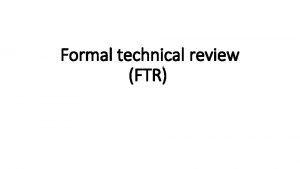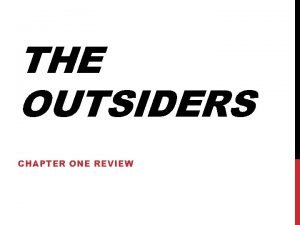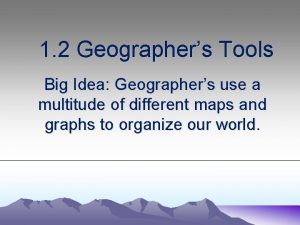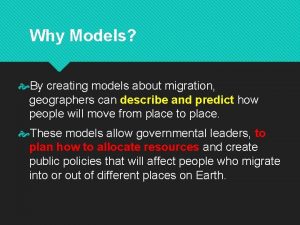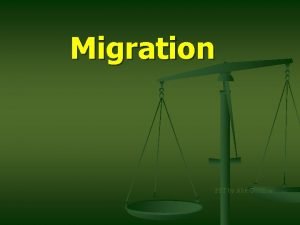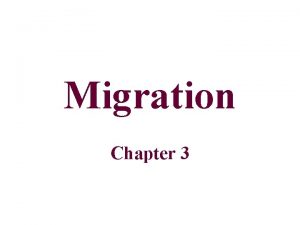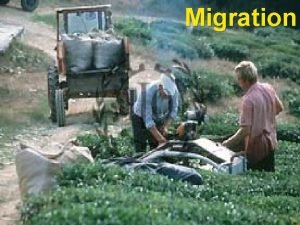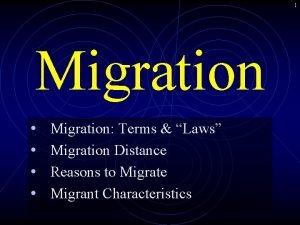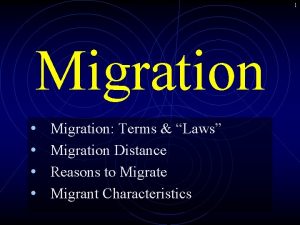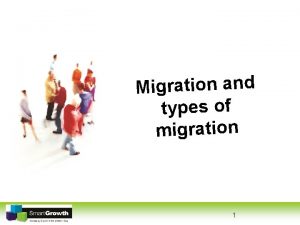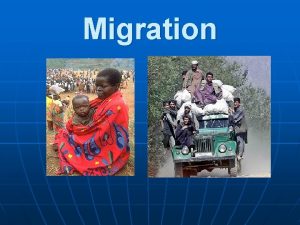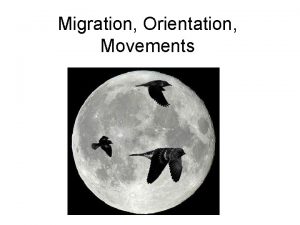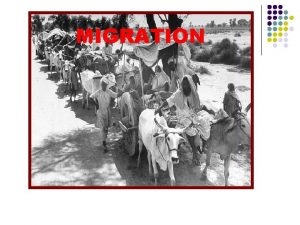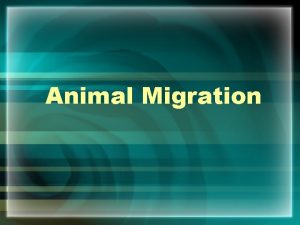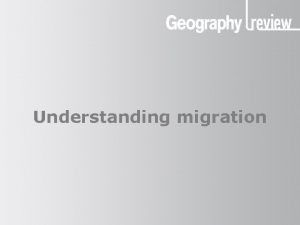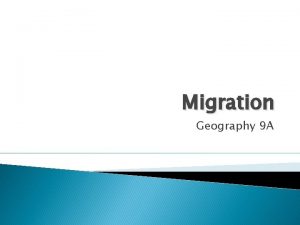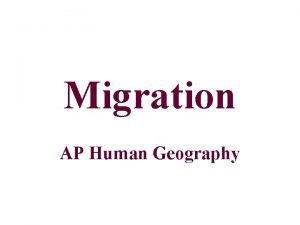Chapter 3 Review Migration Migration Why are Geographers






























- Slides: 30

Chapter 3 Review Migration

Migration • Why are Geographers interested in migration? • 1. Produces profound changes for individuals and cultures. • 2. Permanent moves to a new location disrupts traditional cultural ties. • 3. Disrupts economic patterns • 4. Diffusion of culture; language, religion, ethnicity etc.

Migration • A permanent move to a new location constitutes migration. • Migration is a specific type of relocation diffusion and a form of Mobility is movement from one place to another. • Circulation is a form of Mobility, it refers to the short term repetitive or cyclical movements that recur on a regular basis. Daily, monthly or annually.

Migration • Emigration is migration from a location. • Immigration is migration to a location. • Place “A” can have individuals migrating away from and to it. • Emigrant: Place A → Place B • Immigrant: Place B → Place A • Ex: Moving from the US to Mexico is considered Emigration. While moving from Mexico to the US is considered immigration • Difference between the number of immigrants and number emigrants is a place’s net migration. • If a country has a high net migration rate it is seen as wealthy and developed. In contrast a country with a low rate is seen as undeveloped. • • • Formula for calculating Net Migration N = (I - E) / M X 1, 000 N = Net Migration Rate I = Number of Immigrants Entering the Area E = Number of Emigrants Leaving the Area M = Mid Year Population

Migration • Why Migrate? • Desperate Conditions • Most people migrate in search of three objectives: Economic opportunity, cultural, freedom, and environmental comfort. • Wilbur Zelinsky • Proposed that changes in society are comparable with those in the Demographic Transition Model • Migration transition results from the social and economic changes that are produced in the demographic transition. • Stage 1: Very little migration • Stage 2: International migration • Stage 3 and 4: Internal Migration

Migration • • People decide to migrate because of a combination of two factors. Push factors induce people to move out of their present location. Pull factors induce people to move into a new location. Three major types of push and pull factors Political/Cultural Environmental Economic

Migration • Migration can be divided into two categories. • International Migrationpermanent move from one country to another • Voluntary • Forced • Internal Migration- permanent move within the same country • Interregional • Intraregional • Ravenstein’s laws for the distance that migrants typically move • Most migrants relocate a short distance and remain within the same country. • Long-distance migrants to other countries head for major centers of economic activity.

International Migration • Approximately 9 percent of the world’s people are international migrants. • Global pattern reflects migration tendencies from developing countries to developed countries. • Net Out-Migration • Asia, Latin America, and Africa • Net In-Migration • North America, Europe, and Oceania

International Migration • U. S. has more foreign-born residents than any other country: approximately 43 million as of 2010—growing by 1 million annually. • Three main eras of immigration in the U. S. • Colonial settlement in seventeenth and eighteenth centuries • Mass European immigration in the late 19 th and early twentieth centuries • Asian and Latin American integration in the late Twentieth and early twenty-first centuries

Interregional Migration • • • Internal Migration- permanent move within the same country Interregional Intraregional Interregional Migration Perceived economic betterment typically compels individuals to make interregional migrations. Historically- enticement of abundant available land on the American Frontier. Presently- most jobs, especially in services, are clustered in urban areas. Westward expansion contributed to a shift in the center of population. “Center of population gravity”

Interregional Migration • Since Industrial Revolution began in Europe in nineteenth century, a global trend for individuals to migrate from rural to urban areas • Percentage of urbanized population in U. S. • 1800: 5 percent • 1920: 50 percent • 2010: 80 percent • Motivated by economic advancement • Developed countries experienced a new migration trend during the late twentieth century when rural areas were characterized by net inmigration. • Net migration from urban to rural areas is called counterurbanization. • Counter-urbanization most prevalent in places rich with natural amenities • Rocky Mountain States (Colorado, Idaho, Utah, and Wyoming)

Intraregional migration • Most intraregional migration in developed countries is from cities out to surrounding suburbs. • Motivated not by economic advancement but by a desired lifestyle • Additional privacy associated with single-family detached houses • Garages and driveways offer parking at no additional fee • Often superior suburban schools

Migration between Regions in Large Countries • World’s five largest countries in land area are Russia, Canada, China, the U. S. , and Brazil. • Russia: Interregional migration was encouraged eastward and northward by the government’s decision to locate new factories and to offer economic incentives away from existing population concentrations. • Canada: Shares a similar east to west interregional migration pattern with the U. S. Three westernmost provinces are destinations for interregional migrants. • China: Nearly 100 million people have emigrated from rural interior to large urban areas along east coast where manufacturing is prevalent. • Brazil: Government moved its capital from Rio De Janeiro to Brasília (600 miles from Atlantic Coast) to encourage migration of Atlantic coast residents to move to the interior.

Migration: Political factors • Political factors can be especially compelling push factors, forcing people to migrate from a country. • United Nations High Commissions for Refugees recognizes three groups of forced political migrants. • A refugee has been forced to migrate to avoid a potential threat to his or her life, and he or she cannot return for fear of persecution.

Migration • An internally displaced person (IDP) is similar to a refugee, but he or she has not migrated across an international border. • An asylum seeker is someone who has migrated to another country in hope of being recognized as a refugee. Environmental factors can prompt migration from hazardous environments or pull migrants to attractive regions. • Environmental Pull Factors • Mountains • Sea-sides Warm Climates • Environmental Push Factors • Water: most common environmental threat • Flood • Drought

Migration Most people migrate for economic reasons. Push factor: migrate away from places with few jobs Pull factor: migrate to places where jobs seem to be available U. S. and Canada have been prominent destinations for economic migrants. • Historically individuals migrated from Europe. • More recently Latin America and Asia are primary senders. • •

Migration: Distance • Ravenstein’s laws for the distance that migrants typically move • Most migrants relocate a short distance and remain within the same country. • Long-distance migrants to other countries head for major centers of economic activity.

Ravensteins’s Laws • 19 th Century geographer E. G. Ravenstein wrote a series of “laws” about the tendencies of migrants. His Law is really a theory. • Ravenstein’s laws help geographers make generalizations about where and how far people move. • Most people migrate for economic reasons. • Political and environmental also induce migration but less often. . • Characteristics of Migrants • Ravenstein noted: • Most long-distance migrants are male. • Most long-distance migrants are adult individuals rather than families with children. • Most long-distance migrants are young adults seeking work rather than children or elderly people.

Migration • Distance decay is a geographical term which describes the effect of distance on cultural or spatial interactions. The distance decay effect states that the interaction between two locales declines as the distance between them increase • Tobler’s Law - Everything is related to everything else but nearer things are more related than distant things. • Tyranny of distance (Friction of Distance) - Distance is always there we can’t fight it - Resistance of distance = more money you have to spend • Gravity Model - “Any Two bodies attract one another with a force that is proportional to the product of their masses and inversely proportional to the square of the distance between them. ”

Migration • Intervening obstacles, which hinder migration, can be categorized into two types. • Environmental Feature- i. e. , mountain, ocean, or distance • Political Feature- i. e. , countries require proper documentation to leave one country and gain entry in another

Controlling Migration • Countries have adopted selective immigration policies. • Preference shown for specific employment placement and family reunification • Passing of the Quota Act in 1921 and the National Origins Act in 1924 by the U. S. Congress marked the end of unrestricted immigration to the U. S.

Migration • More seek admission to the U. S. than is permitted by the quotas, thus preferences are shown toward: • Family Reunification • About ¾ of immigrants • Skilled Workers • Approximately ¼ of immigrants • Sending countries alleged preference for skilled workers contributes to brain drain- a term for the disproportionate amount of highly skilled and intelligent citizens migrating away from sending countries. • Diversity • A few immigrants admitted, because their sending country historically has sent very few migrants

Migration • Unauthorized immigrants are those who enter a country without proper documents. • Characteristics of unauthorized immigrates in the U. S. • Source Country • Roughly 58 percent emigrate from Mexico • Children • Of estimated 11. 2 million unauthorized immigrants, nearly 1 million are children. • Unauthorized immigrants have given birth to 4. 5 million children on U. S. soil making the children U. S. citizens.

Migration Years in the U. S. • Duration of residency has increased for unauthorized immigrants. • In 2010, 35 percent of adults had been in U. S. for at least 15 years. Labor Force • Approximately 8 million unauthorized immigrants are employed in the U. S. Distribution • Texas and California have largest number of unauthorized immigrants

Migration Mexico’s Border with the United States • View from the U. S. recognizes motives that compel unauthorized immigrants to enter illegally • Employment Opportunities • Family Reunification Better Way of Life • View from Mexico is more complex • Residents of northern Mexico wish for compassion to be shown to unauthorized immigrants. • Residents of southern Mexico are less tolerant because of number of unauthorized immigrants entering Mexico from Guatemala.

Migration Immigration Concerns in the U. S. Most views of immigration by U. S. citizens are ambivalent in nature. Border Patrol They would like more effective border control, but they don’t want to spend more money to solve the issue. • Workplace • Most recognize that unauthorized immigrants take jobs from U. S. citizens, but they understand most citizens wouldn’t take the jobs so they support a path to U. S. citizenship for these unauthorized immigrants. • •

Migration • Civil Rights • U. S. citizens favor letting law enforcement officials stop and verify the legal status of anyone, but they fear civil rights will be infringed upon of U. S. citizens, as a result of racial profiling. • Local Initiatives • Polls suggest U. S. citizens believe unauthorized immigration is a pressing matter to the nation, but it should only be dealt with at the federal level and not the local level. • Many were opposed to Arizona’s 2010 law that obligated foreigners to carry a proof of citizenship with them at all times. • More than 100 localities across the nation support additional rights for unauthorized immigrants—such a movement is known as a “Sanctuary City. ”

Migration • Immigration Concerns in Europe • Population growth in Europe is fueled by immigration from other regions of the world, a trend disliked by many Europeans. • Biggest fear is that the host country’s culture will be lost, because immigrants: • adhere to different religions • speak different languages • practice different food and other cultural habits • Hostility to immigrants has become a central plank of some political parties in many European countries. • Immigrants blamed for crime, unemployment rates, and high welfare costs.

Migration • Europeans as Emigrants • Inhospitable climate for immigrants in Europe is especially ironic. • Europe was the source of most of the world’s emigrants, during the nineteenth century. • Most Europeans fear losing their cultural heritage to that of new immigrants, while: • Indo-European languages are now spoken by half of the world, as a result of European emigrants. • Christianity has the world’s largest number of adherents. • European art, music, literature, philosophy, and ethics have diffused throughout the world.

Migration Characteristics of Migrants Ravenstein noted: Most long-distance migrants are male. Most long-distance migrants are adult individuals rather than families with children. • Most long-distance migrants are young adults seeking work rather than children or elderly people. • • • Characteristics of Migrants • More males migrated to the U. S. during the nineteenth century and most of the twentieth century. • Gender reversed in 1990 s when women constituted about 55 percent of U. S. immigrants. • Most likely a reflection of the changing role of women in Mexican society. • About 40 percent of immigrants in U. S. are young adults between the ages of 25 and 39. • Recent immigrants to the U. S. tend to be less educated than U. S. citizens.
 Antigentest åre
Antigentest åre Formal vs functional region
Formal vs functional region Why do geographers call arabia a crossroads location
Why do geographers call arabia a crossroads location Why do geographers use population pyramids
Why do geographers use population pyramids Why do geographers study religion
Why do geographers study religion Why are geographers concerned with scale and connectedness?
Why are geographers concerned with scale and connectedness? Andreas carlsson bye bye bye
Andreas carlsson bye bye bye Geographers tools
Geographers tools Geographers look at the world
Geographers look at the world What map is this
What map is this Geographers tools
Geographers tools What basic questions guide geographers
What basic questions guide geographers How geographers look at the world worksheet answers
How geographers look at the world worksheet answers Dont ask
Dont ask Chapter review motion part a vocabulary review answer key
Chapter review motion part a vocabulary review answer key Chapter 6 career readiness chapter review answers
Chapter 6 career readiness chapter review answers Ap gov review final exam review
Ap gov review final exam review Nader amin-salehi
Nader amin-salehi Traditional and systematic review venn diagram
Traditional and systematic review venn diagram Narrative review vs systematic review
Narrative review vs systematic review Migration chapter class 5
Migration chapter class 5 Ftr quality assurance
Ftr quality assurance Why-why analysis
Why-why analysis Why do you cry willie why do you cry
Why do you cry willie why do you cry Does this table represent a function why or why not
Does this table represent a function why or why not Does this table represent a function why or why not
Does this table represent a function why or why not Why or why not
Why or why not Analisa akar masalah
Analisa akar masalah Chapter 6 quotes to kill a mockingbird
Chapter 6 quotes to kill a mockingbird The outsiders chapter review
The outsiders chapter review Chapter 18 review chemical equilibrium
Chapter 18 review chemical equilibrium

